Fission Stories #180
In early August 2014, the Tokyo Electric Power Company (TEPCO) announced that its latest analysis revealed the meltdown of the Unit 3 reactor at Fukushima Daiichi was worse than previously estimated.
Recall children’s books with dots and numbers? Children connect the dots to reveal pictures of clowns and puppies and spaceships and such.
TEPCO is essentially painting pictures using very few dots with no numbers. They keep running computer studies that put numbers almost randomly on the few dots they have to see what picture emerges. “Lo and behold” to quote a professor I had in college, different pictures emerge.
TEPCO doesn’t know when the Unit 3 core damage began
Or how much of the reactor core was damaged.
Or how and when the damaged core relocated after melting.
Or how, when, and where the molten burned through the reactor pressure vessel.
Or how it moved after it fell onto the containment’s concrete floor.
And they don’t know how much water, if any, was on the containment floor when the molten core joined it.
TEPCO fills in these information gaps with guesses. And they keep revising their results because they keep revising their guesses.
Our Takeaway
I choose not to play rate-a-guess. It would take me away from helping my nephew finish his connect-the-dots drawing. Only seven numbers remain to be connected. While it resembles a race car now, it might yet turn out to be a giraffe. Or maybe even a kitten.
Before I decide which TEPCO picture I most prefer, they are going to have to fetch more dots and put real numbers on as many of them as possible.
At some point in the next few years, TEPCO will maneuver a robot into the reactor area. That will reveal what the former reactor core looks like now. This information won’t answer all the questions, but it’ll number several more dots to support a meaningful analysis of what happened when.
Until then, TEPCO is just keeping their computer jockeys busy. They could get results of similar value using Ouija boards—and it would reduce their carbon footprint.
“Fission Stories” is a weekly feature by Dave Lochbaum. For more information on nuclear power safety, see the nuclear safety section of UCS’s website and our interactive map, the Nuclear Power Information Tracker.

